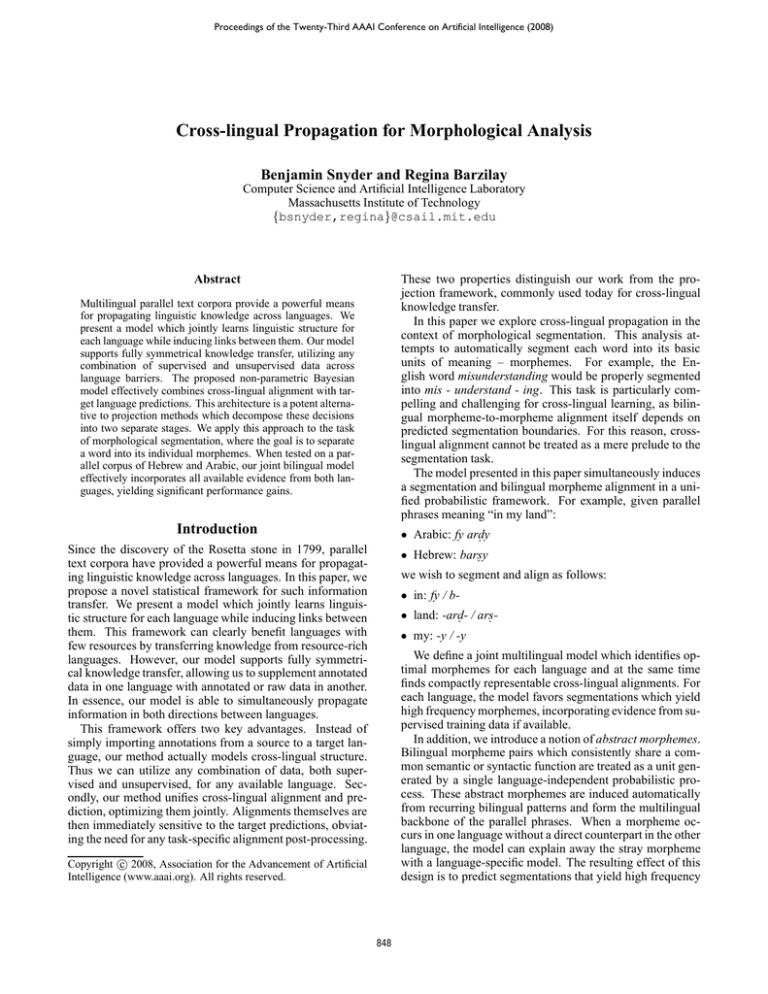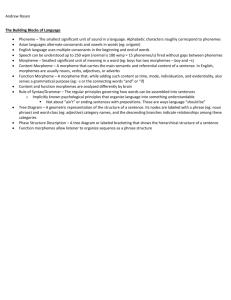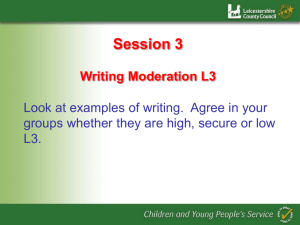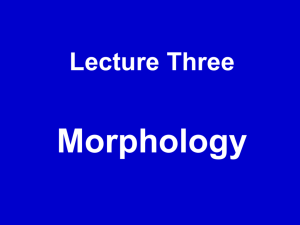
Proceedings of the Twenty-Third AAAI Conference on Artificial Intelligence (2008)
Cross-lingual Propagation for Morphological Analysis
Benjamin Snyder and Regina Barzilay
Computer Science and Artificial Intelligence Laboratory
Massachusetts Institute of Technology
{bsnyder,regina}@csail.mit.edu
These two properties distinguish our work from the projection framework, commonly used today for cross-lingual
knowledge transfer.
In this paper we explore cross-lingual propagation in the
context of morphological segmentation. This analysis attempts to automatically segment each word into its basic
units of meaning – morphemes. For example, the English word misunderstanding would be properly segmented
into mis - understand - ing. This task is particularly compelling and challenging for cross-lingual learning, as bilingual morpheme-to-morpheme alignment itself depends on
predicted segmentation boundaries. For this reason, crosslingual alignment cannot be treated as a mere prelude to the
segmentation task.
The model presented in this paper simultaneously induces
a segmentation and bilingual morpheme alignment in a unified probabilistic framework. For example, given parallel
phrases meaning “in my land”:
Abstract
Multilingual parallel text corpora provide a powerful means
for propagating linguistic knowledge across languages. We
present a model which jointly learns linguistic structure for
each language while inducing links between them. Our model
supports fully symmetrical knowledge transfer, utilizing any
combination of supervised and unsupervised data across
language barriers. The proposed non-parametric Bayesian
model effectively combines cross-lingual alignment with target language predictions. This architecture is a potent alternative to projection methods which decompose these decisions
into two separate stages. We apply this approach to the task
of morphological segmentation, where the goal is to separate
a word into its individual morphemes. When tested on a parallel corpus of Hebrew and Arabic, our joint bilingual model
effectively incorporates all available evidence from both languages, yielding significant performance gains.
Introduction
• Arabic: fy ard.y
Since the discovery of the Rosetta stone in 1799, parallel
text corpora have provided a powerful means for propagating linguistic knowledge across languages. In this paper, we
propose a novel statistical framework for such information
transfer. We present a model which jointly learns linguistic structure for each language while inducing links between
them. This framework can clearly benefit languages with
few resources by transferring knowledge from resource-rich
languages. However, our model supports fully symmetrical knowledge transfer, allowing us to supplement annotated
data in one language with annotated or raw data in another.
In essence, our model is able to simultaneously propagate
information in both directions between languages.
This framework offers two key advantages. Instead of
simply importing annotations from a source to a target language, our method actually models cross-lingual structure.
Thus we can utilize any combination of data, both supervised and unsupervised, for any available language. Secondly, our method unifies cross-lingual alignment and prediction, optimizing them jointly. Alignments themselves are
then immediately sensitive to the target predictions, obviating the need for any task-specific alignment post-processing.
• Hebrew: bars.y
we wish to segment and align as follows:
• in: fy / b• land: -ard.- / ars.• my: -y / -y
We define a joint multilingual model which identifies optimal morphemes for each language and at the same time
finds compactly representable cross-lingual alignments. For
each language, the model favors segmentations which yield
high frequency morphemes, incorporating evidence from supervised training data if available.
In addition, we introduce a notion of abstract morphemes.
Bilingual morpheme pairs which consistently share a common semantic or syntactic function are treated as a unit generated by a single language-independent probabilistic process. These abstract morphemes are induced automatically
from recurring bilingual patterns and form the multilingual
backbone of the parallel phrases. When a morpheme occurs in one language without a direct counterpart in the other
language, the model can explain away the stray morpheme
with a language-specific model. The resulting effect of this
design is to predict segmentations that yield high frequency
c 2008, Association for the Advancement of Artificial
Copyright Intelligence (www.aaai.org). All rights reserved.
848
application anew, and allows cross-lingual learning when
alignment cannot logically be separated from the task.
Projection for Morphological Segmentation Morphological analysis has been extensively studied in the past. We
focus our discussion on two algorithms that employ projection for morphological analysis. The first projection algorithm developed by (Yarowsky, Ngai, and Wicentowski
2000) aims to predict the roots of both regular and irregular conjugated words. Root information is projected from
English to French using multi-step transitive associations
computed from IBM alignments. Since the mapping procedure does not analyze the underlying strings, annotations for
words that do not have a corresponding root form in the target corpus cannot be projected. This annotation deficiency
could be particularly severe for semitic languages known for
their rich morphology.
(Rogati, McCarley, and Yang 2003) address this limitation in the context of Arabic by modeling probabilities of
prefixes and suffixes as well as stems. An important source
of the model’s performance is the availability of an additional large monolingual corpus in the target language. Our
segmentation task differs from the task of lemmatization explored in these two papers. Our goal is to fully segment
a word into its constituent morphemes, whether those consist of multiple lemmas (as in agglutinative languages) or
a rich vocabulary of prepositions and grammatical markers
(as in the Semitic languages). In this scenario, alignment
and segmentation are logically codependent and thus these
two stages cannot be executed in a sequential manner.
individual-language morphemes as well as common bilingual morpheme pairs.
To achieve this effect in a sound probabilistic framework,
we formulate a non-parametric hierarchical Bayesian model
with Dirichlet Process priors. This framework allows us
to define prior distributions over the infinite set of possible morphemes in each language as well as over all possible aligned pairs of morphemes across languages. Despite
assigning positive probability to every possible string, the
resulting distributions concentrate their probability mass on
a small group of recurring and stable patterns. This feature
captures the intuition that hidden structure which most succinctly represents the data should be inferred.
We evaluate our model on a parallel corpus of Hebrew and
Arabic short phrases extracted from the Bible. First we show
that our model propagates information effectively from a
resource-rich source language to a target language with no
annotation. Furthermore, we find that even the resulting predictions in the annotated source language improve significantly through cross-lingual learning. This result is striking
given that the only new source of information is unannotated data in a foreign language. Finally, we find that when
the cross-lingual model is given supervised data in both languages, the performance exceeds that of individually trained
monolingual models.
Related Work
Cross-lingual Learning Today, most work on cross-lingual
learning is performed in the projection framework introduced by (Yarowsky, Ngai, and Wicentowski 2000). By
definition projection is asymmetrical: knowledge is transferred from a resource-rich source language to a resourcepoor target language. This method follows a two-step architecture. First, annotations are projected from the source
language to the target language via alignments. The resulting pseudo-annotations are in turn used for supervised
learning in the target language. Since the quality of the projected annotations is crucial for successful learning, the accuracy of the alignment step is always a concern for projection methods. Multiple empirical results have demonstrated that using out-of-the-box alignment methods, such as
GIZA++, is insufficient. Therefore, researchers have developed task-specific methods for filtering spurious mappings
and post-correcting automatic alignments (Hwa et al. 2005;
Rogati, McCarley, and Yang 2003; Padó and Lapata 2005).
For instance, in projecting semantic roles, alignments are refined by analyzing syntactic constituents and removing those
with low similarity scores. In this and other applications, the
alignment correction step is essential for successful learning.
In contrast to the projection framework, our model is
fully symmetric in the parallel languages. This feature
allows multi-directional knowledge transfer between languages, each with possibly different levels of supervision.
Furthermore, our method performs alignment and prediction simultaneously, thus supporting interaction between the
two steps. In this way, alignments induced by the model
optimize the performance of the task at hand. This design
reduces the need for crafting post-correction rules for each
Cross-lingual Propagation Scenarios
In this paper we consider three scenarios of cross-lingual
knowledge transfer. We assume that during training, a parallel corpus is available. The presence of annotated data varies
in each scenario:
1. Indirect Supervision: No supervised data is available in
the target language. However annotated resources exist
for source languages. This is the classical scenario for
projection methods (Yarowsky, Ngai, and Wicentowski
2000).
2. Augmentation: Supervised data is already available in
the language of interest, but can be supplemented with
unsupervised data in additional languages.
3. Shared Supervision: Supervised data is available for
both languages.
This range of scenarios mirrors actual multilingual data
availability. Even when supervised data is available in both
languages, the annotation may not cover the entire parallel
corpus. Moreover, each language in the parallel corpus may
have a different set of data points annotated. Therefore, in
all scenarios with annotations, we assume the presence of
additional unannotated parallel data.
Our model effectively generalizes the idea of multilingual
knowledge transfer beyond the simple scenario of indirect
supervision. While the benefits of indirect supervision seem
intuitively plausible (and have been previously demonstrated
through the use of annotation projection in other tasks), it is
849
not at all obvious whether data in a foreign language can be
of use when native supervision is already present. We hypothesize that knowledge of shared linguistic structure can
in fact yield benefits across the range of these scenarios. The
results of this paper provide some evidence for this claim.
the formulation can be extended to accommodate evidence
from multiple languages as well. We provide an example of
a generated parallel bilingual phrase in Figure 1.
High-level Generative Story
We have a parallel corpus of several thousand short phrases
in the two languages E and F . Our model provides a generative story explaining how these parallel phrases were generated probabilistically. The core of the model consists of
three components: a distribution A over bilingual morpheme
pairs (abstract morphemes), a distribution E over stray morphemes in language E occurring without a counterpart in
language F , and a similar distribution F for stray morphemes in language F . As usual for hierarchical Bayesian
models, the generative story begins by drawing the model
parameters themselves – in our case the three distributions
A, E, and F .
These three distributions are drawn from three separate
Dirichlet processes, each with appropriately defined base
distributions. This ensures that the resulting distributions
concentrate their probability mass on a small number of
morphemes while holding out reasonable probability for unseen possibilities.
Once these distributions have been drawn, we model our
parallel corpus of short phrases as a series of independent
draws from a phrase-pair generation model. For each new
phrase-pair, the model first chooses the number and type of
morphemes to be generated. In particular, it must choose
how many unaligned stray morphemes from language E,
unaligned stray morphemes from language F , and abstract
morphemes are to compose the parallel phrases. These three
numbers, respectively denoted as m, n, and k, are drawn
from a Poisson distribution. This step is illustrated in Figure
1 part (a).
The model then proceeds to independently draw m
language-E morphemes from distribution E, n language-F
morphemes from distribution F , and k abstract morphemes
from distribution A. This step is illustrated in part (b) of
Figure 1.
The m + k resulting language-E morphemes are then ordered and fused to form a phrase in language E, and the n+k
resulting language-F morphemes are ordered and fused to
form the parallel phrase in language F . The ordering and
fusing decisions are modeled as draws from a uniform distribution over the set of all possible orderings and fusings
for sizes m, n, and k. These final steps are illustrated in
parts (c)-(d) of Figure 1. Now we describe the model more
formally.
Model
Overview
In order to simultaneously model probabilistic dependencies
across languages as well as morpheme distributions within
each language, we employ a Bayesian graphical model. This
setting allows us to easily accommodate supervised as well
as unsupervised data in a single framework. This class of
models allows inference to be easily performed with a mix
of observed and unobserved variables. When the quantity of
observed data in a particular language is limited, the model
can fall back upon reasonable prior distributions.
Our segmentation model is based on the notion that stable recurring string patterns within words are indicative of
morphemes. These patterns are anchored by the presence
of supervised segmentations in one or more languages. Our
model assigns high probability to morphemes with high actual frequency in supervised portions and high potential frequency in unsupervised portions of the data. In this way, supervised and unsupervised learning are integrated in a single
probabilistic framework.
In addition to learning independent morpheme patterns
for each language, the model will prefer, when possible, to
join together frequently co-occurring bilingual morpheme
pairs into single abstract morphemes. This aspect of the
model is fully unsupervised and is driven by a preference
for stable and high frequency cross-lingual morpheme patterns. Our model thus combines the totality of supervised
and unsupervised data within each language with unsupervised learning of cross-lingual morpheme alignments.
Our aim is to induce a model which concentrates probability on highly frequent patterns while still allowing for
the possibility of those previously unseen. Dirichlet processes are particularly suitable for such conditions. In this
framework, we can encode prior information over the infinite set of possible morpheme strings as well as aligned morpheme pairs. Distributions drawn from a Dirichlet process
nevertheless produce sparse representations with most probability mass concentrated on a small number of observed
and predicted patterns. Our model utilizes a Dirichlet Process1 prior for each language, as well as for the cross-lingual
links (abstract morphemes). Thus, a distribution over morphemes and morpheme alignments is first drawn from the set
of Dirichlet processes and then produces the observed data.
In practice, we never deal with such distributions, but rather
integrate over them during Gibbs sampling.
In the next section we describe our model’s “generative
story” for producing the data we observe. We formalize our
model in the context of two languages E and F . However,
Stray Morpheme Distributions
To model morphemes which occur in a phrase in one language without a corresponding foreign language morpheme
in the parallel phrase (“stray morphemes”), we employ
language-specific morpheme distributions.
For each language, we draw a distribution over all possible morphemes (finite-length strings composed of characters
in the appropriate alphabet) from a Dirichlet process with
concentration parameter α and base distribution Pe or Pf
respectively:
1
The use of Dirichlet processes in a Bayesian framework has
found recent success across a variety of applications in NLP (Goldwater, Griffiths, and Johnson 2006; Finkel, Grenager, and Manning
2007; Haghighi and Klein 2007).
850
(a)
(b)
(c)
m=1
n=1
k=4
A
E
at
h
(ACC)
knʿn
yn (PLURAL)
(canaan)
knʿn
F
w (and)
w
(d)
(and) (ACC) (the) (canaan) (of)
y
w at h knʿn
y
and-ACC
the-canaan-of
w-at
h-knʿn-y
(the)
al
(of)
y
w
(and)
al knʿn
(the) (canaan)
y
yn
(of) (PLURAL)
w-al-knʿn-y-yn
and-the-canaan-of-PLURAL
ואת הכנעני
"...and the Canaanites"
والكنعنيين
Figure 1: Generation process for a parallel bilingual phrase. (a) First the numbers of stray and abstract morphemes are drawn
from a Poisson distribution. (b) Stray morphemes are then drawn from E and F (language-specific distributions) and abstract
morphemes are drawn from A. (c) The resulting morphemes are ordered. (d) Finally, some of the contiguous morphemes are
fused into words.
E|α, Pe
F |α, Pf
∼
∼
A|α′ , P ′
(e, f )
DP (α, Pe )
DP (α, Pf )
∼ DP (α′ , P ′ )
∼ A
As before, the resulting distribution A will give non-zero
probability to all abstract morphemes (e, f ). The base distribution P ′ , which acts as a prior on such pairs, can encode
existing cross-lingual knowledge by, for example, taking the
string edit distance between e and f into account. However
in our experiments for this paper we simply used a mixture
of geometric distributions in the lengths of the component
morphemes.
The base distributions Pe and Pf can encode prior knowledge about the properties of morphemes in each of the two
languages, such as length and character n-grams. For simplicity, we use a geometric distribution over the length of the
string. The distributions E and F which result from the respective Dirichlet processes place most of their probability
mass on a small number of morphemes with the degree of
concentration controlled by the prior α. Nevertheless, some
non-zero probability is reserved for every possible string.
We note that these single-language morpheme distributions also serve as monolingual segmentation models, and
similar models have been successfully applied to the task of
word boundary detection (Goldwater, Griffiths, and Johnson 2006).
Phrase Generation
To generate a bilingual parallel phrase, we first draw m,
n, and k independently from a Poisson distribution. These
three integers represent the number and type of the morphemes that compose the parallel phrase, giving the number of stray morphemes in each language E and F and the
number of coupled bilingual morpheme pairs, respectively.
m, n, k
∼ P oisson(λ)
Given these values, we now draw the appropriate number of stray and abstract morphemes from the corresponding
distributions:
Abstract Morpheme Distribution
To model the connections between morphemes across languages, we further define a model for bilingual morpheme
pairs, or abstract morphemes. This model assigns probabilities to all pairs of morphemes – that is, all pairs of finite
strings from the respective alphabets – (e, f ). Intuitively,
we wish to assign high probability to pairs of morphemes
that play similar syntactic or semantic roles (e.g. (fy, b-)
for “in” in Arabic and Hebrew). These morpheme pairs can
thus be viewed as representing abstract morphemes. As with
the single language models, we wish to define a distribution
which concentrates probability mass on a small number of
highly co-occurring morpheme pairs while still holding out
some probability for all other pairs.
We define this abstract morpheme model A as a draw from
another Dirichlet process:
e1 , ..., em
f1 , ..., fn
∼
∼
E
F
(e′1 , f1′ ), ..., (e′k , fk′ )
∼
A
The set of morphemes drawn for each language are then
ordered:
ẽ1 , ..., ẽm+k
f˜1 , ..., f˜n+k
851
∼
ORDER|e1 , ..., em , e′1 , ..., e′k
∼
ORDER|f1 , ..., fn , f1′ , ..., fk′
and finally fused into the words that form the parallel
phrases:
w1 , ..., ws
∼
v1 , ..., vt
∼
by jointly sampling multiple segmentation and alignment
decisions. We also collapse our Gibbs sampler in the standard way, by using predictive posteriors marginalized over
all possible draws from the Dirichlet processes (resulting in
Chinese Restaurant Processes).
F U SE|ẽ1 , ..., ẽm+k
F U SE|f˜1 , ..., f˜n+k
Resampling
For each bilingual phrase, we resample in turn each word in
the phrase. Consider word w in language E. If the word has
been segmented by manual annotation, then that segmentation stays fixed and we need only resample alignment decisions. Otherwise, we consider at once all possible segmentations, and for each segmentation all possible alignments.
We keep fixed the previously sampled segmentation decisions for all other words in the phrase as well as sampled
alignments involving morphemes in other words. We are
thus considering at once: all possible segmentations of w
along with all possible alignments involving morphemes in
w with some subset of previously sampled language-F morphemes.2
The sampling formulas are easily derived as products of
the relevant Chinese Restaurant Processes (with a minor adjustment to take into account the number of stray and abstract morphemes resulting from each decision). See (Neal
1998) for general formulas for Gibbs sampling from distributions with Dirichlet process priors.
To keep the model as simple as possible, we employ uniform distributions over the sets of orderings and fusings.
In other words, given a set of r morphemes (for each language), we define the distribution over permutations of the
1
morphemes to simply be ORDER(·|r) = r!
. Then, given
a fixed morpheme order, we consider fusing each adjacent
morpheme into a single word. Again, we simply model the
distribution over the r − 1 fusing decisions uniformly as and
1
.
F U SE(·|r) = 2r−1
Implicit Alignments
Note that nowhere do we explicitly assign probabilities to
morpheme alignments between parallel phrases. However,
our model allows morphemes to be generated in precisely
one of two ways: as a lone stray morpheme or as part of
a bilingual abstract morpheme pair. Thus, our model implicitly assumes that each morpheme is either unaligned, or
aligned to exactly one morpheme in the opposing language.
If we are given a parallel phrase with already segmented
morphemes we can easily induce the distribution over alignments implied by our model. As we will describe in the next
section, drawing from these induced alignment distributions
plays a crucial role in our inference procedure.
Experimental Set-Up
Morpheme Definition Our practical definition of a morpheme includes conjunctions, prepositional and pronominal
affixes, plural and dual suffixes, particles, and roots. We do
not consider cases of infixed morpheme transformations, as
those cannot be modeled by linear segmentation.
Dataset As a source of parallel data, we use the Hebrew
Bible and an Arabic translation. For the Hebrew version,
we use an edition distributed by the Westminster Hebrew
Institute (Groves and Lowery 2006). This Bible edition is
augmented by gold standard morphological analysis which
includes segmentation. This analysis has been performed by
linguists and biblical scholars.
For the Arabic version, we use the Van Dyke Arabic translation.3 We obtain gold standard segmentation with a hand
crafted Arabic morphological analyzer which utilizes manually constructed word lists and compatibility rules and is
further trained on a large corpus of hand annotated Arabic
data (Habash and Rambow 2005).
To obtain our corpus of short parallel phrases, we preprocessed the biblical data using the Giza++ alignment toolkit.4
Given word alignments between the Arabic and Hebrew versions of the Bible, we extract a list of phrase pairs that form
Inference
Given our corpus of short parallel bilingual phrases, we wish
to make segmentation decisions which yield a set of morphemes with high joint probability. To assess the probability
of a potential morpheme set, we need to marginalize over all
possible alignments (i.e. possible abstract morpheme pairings and stray morpheme assignments). We also need to
marginalize over all possible draws of the distributions A,
E, and F from their respective Dirichlet process priors. We
achieve these aims by performing Gibbs sampling.
Sampling
We follow (Neal 1998) in the derivation of our blocked and
collapsed Gibbs sampler. Gibbs sampling starts by initializing all random variables to arbitrary starting values. At
each iteration, the sampler selects a random variable Xi ,
and draws a new value for Xi from the conditional distribution of Xi given the current value of the other variables:
P (Xi |X−i ). The stationary distribution of variables derived
through this procedure is guaranteed to converge to the true
joint distribution of the random variables. However, if some
variables can be jointly sampled, then it may be beneficial to
perform block sampling of these variables to speed convergence. In addition, if a random variable is not of direct interest, we can avoid sampling it directly by marginalizing it out,
yielding a collapsed sampler. We utilize variable blocking
2
We retain morpheme identities during resampling of the morpheme alignments. This procedure is technically justified by augmenting the model with a pair of “morpheme-identity” variables
deterministically drawn from each abstract morpheme. Thus the
identity of the drawn morphemes can be retained even while resampling their generation mechanism.
3
http://www.arabicbible.com/bible/vandyke.htm
4
http://www.fjoch.com/GIZA++.html
852
key
RANDOM
MORFESSOR
UNSUPERVISED
SUPERVISED
INDIRECT SUPERVISION
AUGMENTATION
SHARED SUPERVISION
u
u
u
s
us
su
ss
precision
18.28
71.10
52.95
73.15
64.37
76.01
77.78
Arabic
recall f-measure
19.24
18.75
60.51
65.38
78.46
63.22
92.39
81.65
80.81
71.65
92.21
83.33
92.26
84.39
precision
24.95
65.38
55.76
71.44
63.10
75.98
76.81
Hebrew
recall f-measure
24.66
24.80
57.69
61.29
64.44
59.78
79.14
75.09
68.02
65.46
78.04
77.00
79.17
77.98
Table 1: Precision, recall and f-measure for Arabic and Hebrew in various cross-lingual scenarios. The key indicates the
combination of supervised/unsupervised for target language (left) and source language (right).
independent sets in the bipartite alignment graph. This process allows us to group together phrases like fy als.bah. in
Arabic and bbqr in Hebrew while being reasonably certain
that all the relevant morphemes are contained in the short
extracted phrases. The monolingual part of such phrases
ranges from one to three words. Before performing any experiments, a manual inspection of the extracted phrases revealed that many infrequent phrase pairs occurred merely as
a result of noisy translation and alignment. Therefore, we
eliminated all phrase pairs that occur fewer than five times.
As a result of this process, we obtain 6,139 phrase pairs. The
number of morphemes per word ranges from 1 to 6 for both
Hebrew and for Arabic. The average number of morphemes
per word in the Hebrew gold data is 1.8, and is 1.7 for Arabic.
Training and Testing We randomly select 1/5 of the data
for testing, and 4/5 for training. As discussed above, for the
scenarios that involve supervision, we use half of the training set as annotated data and the other half as unannotated
data. We emphasize that when testing model performance in
each language no multilingual information on test cases is
used. This allows us to gauge the performance of the model
trained in a multilingual setting on future test cases where
only monolingual data is available.
The training data itself consists of parallel phrases in Hebrew and Arabic. For example, such a training pair would
include the Arabic phrase fy als.bah. along with the Hebrew
bbqr (in the morning). Depending on the exact learning scenario (indirect supervision, augmentation, or shared supervision) some segmentation information may be available.
In any case, no alignment between individual morphemes
is ever provided.
We give results for all such scenarios in order to test our
hypothesis that learning shared linguistic structure across
languages can produce significant benefits in a wide range
of cases. All results are averaged over five runs of Gibbs
sampling with simulated annealing.
Evaluation Methods Following previous work, we evaluate the performance of our segmentation algorithm using
F-score. This measure is the harmonic mean of recall and
precision, which are obtained from the binary segmentation
decisions made between each character in a word.
Baselines Although our main purpose is to compare the
various cross-lingual propagation scenarios with our equiv-
alent monolingual model, we also provide two baselines
in Table 1. The first, RANDOM, makes segmentation decisions based on a coin weighted with the true segmentation frequency. As one might expect, this results in very
poor performance. We also provide results from MORFES SOR(Creutz and Lagus 2007), a state-of-the-art unsupervised morphological segmenter. The results indicate that
our own unsupervised monolingual model is quite competitive with MORFESSOR and is thus a reasonable basis for our
cross-lingual model.
Results
Table 1 shows the performance of various propagation models on the Arabic-Hebrew dataset. In addition, the table
shows the performance of our segmentation model when applied in supervised and unsupervised monolingual settings.
In this scenario only the language-specific morpheme distributions E and F are used to model the data (both supervised
and unsupervised).
Some of these results are to be expected. The monolingual
supervised models achieve relative error reduction of 50%
and 38% over their unsupervised monolingual counterparts
(for Arabic and Hebrew respectively). Perhaps also not surprising is the performance of the models in the Indirect Supervision scenario. In this setting, the performance is found
to lie somewhere between that of the unsupervised and supervised monolingual models. Crudely put, we observe that
the benefit of foreign language annotation is somewhere between one third and half that of native annotation. For instance, while the monolingual unsupervised model achieves
63.22% F-measure on Arabic, once supervised Hebrew data
is added to the mix, Arabic performance rises to 71.65%,
nearly halfway to native Arabic supervised performance of
81.65%.
More surprising are the results in the other propagation
scenarios. In the augmentation setting, we find that the addition of unsupervised foreign language data improves performance even when native annotated data is available. For
example, while the monolingual supervised model achieves
75% F-measure on Hebrew, once unsupervised Arabic data
is added, Hebrew performance rises to 77%. Moreover, in
the shared supervision scenario, where both native and foreign annotations are available, we see even higher results.
Performance rises to 84.39% for Arabic and 77.98% for He-
853
(a)
"for the ram"
???-ram
ll-kbs̆
(b)
"Phineas" (proper name)
for-the-ram
l-(a)l-kbs̆
l-ayl
(c)
"your progeny"
progeny-your
fynhạ s
in-copper
nsl-k
???
fy-nhạ s
nslk
pynhṣ
for-ram
zrʿ-k
seed-your
Figure 2: Examples of errors in the monolingual Arabic model, corrected when annotated Hebrew data is provided.
brew. These findings are consistent across both languages
and across the three evaluation metrics.
way through joint analysis. Furthermore, we will investigate the application of the cross-lingual propagation method
to higher level linguistic structure induction, such as part-ofspeech tagging and parsing.5
Analysis
First we note that in all the cross-lingual scenarios our model
predicts about 0.54 stray morphemes for each language per
phrase and about 1.3 abstract morphemes (for a total of 2.6
aligned morphemes). This indicates that as designed, the
model prefers to generate the data via cross-lingual patterns
when possible.
We also illustrate the benefits of our model with three
examples taken from the indirect supervision scenario and
shown in Figure 2. Here Hebrew is the annotated source
language, and Arabic is the unannotated target language. In
example (a), the monolingual segmenter fails to separate the
preposition l- (“for”) from the definite article -(a)l- and treats
the combination ll- as a single morpheme. However, when
the parallel Hebrew segmentation is provided, the model
recognizes the common abstract morpheme (l-/l-) and thus
segments the Arabic correctly. In example (b), the monolingual Arabic segmenter made a reasonable guess for a previously unseen word. However, the Hebrew data reveals
that this is actually a single morpheme – in fact, a proper
name – and the cross-lingual arabic segmenter follows accordingly. Finally, in (c), we have an interesting case where
in fact the gold standard (hand-crafted) segmenter mistook
the word nslk for a single morpheme. However, the crosslingual Arabic segmenter was able to learn from the parallel
Hebrew data that in fact this word is to be analyzed as two
morphemes: “your progeny.” Unfortunately, in this case our
model was penalized for having the correct answer.
References
Creutz, M., and Lagus, K. 2007. Unsupervised models for
morpheme segmentation and morphology learning. ACM
Transactions on Speech and Language Processing 4(1).
Finkel, J. R.; Grenager, T.; and Manning, C. D. 2007. The
infinite tree. In Proceedings of the ACL, 272–279.
Goldwater, S.; Griffiths, T. L.; and Johnson, M. 2006. Contextual dependencies in unsupervised word segmentation.
In Proceedings of the ACL.
Groves, A., and Lowery, K., eds. 2006. The Westminster
Hebrew Bible Morphology Database. Philadelphia, PA,
USA: Westminster Hebrew Institute.
Habash, N., and Rambow, O. 2005. Arabic tokenization,
part-of-speech tagging and morphological disambiguation
in one fell swoop. In Proceedings of the ACL, 573–580.
Haghighi, A., and Klein, D. 2007. Unsupervised coreference resolution in a nonparametric bayesian model. In
Proceedings of the ACL, 848–855.
Hwa, R.; Resnik, P.; Weinberg, A.; Cabezas, C.; and Kolak,
O. 2005. Bootstrapping parsers via syntactic projection
across parallel texts. Journal of Natural Language Engineering 11(3):311–325.
Neal, R. M. 1998. Markov chain sampling methods for
dirichlet process mixture models. Technical Report 9815,
Dept. of Statistics and Dept. of Computer Science, University of Toronto.
Padó, S., and Lapata, M. 2005. Cross-linguistic projection
of role-semantic information. In Proceedings of the HLT,
859–866.
Rogati, M.; McCarley, J. S.; and Yang, Y. 2003. Unsupervised learning of arabic stemming using a parallel corpus.
In Proceedings of the ACL, 391–398.
Yarowsky, D.; Ngai, G.; and Wicentowski, R. 2000. Inducing multilingual text analysis tools via robust projection
across aligned corpora. In Proceedings of HLT, 161–168.
Conclusions
In this paper we introduce a novel class of multilingual models. Rather than using parallel data as a means for annotation transfer, we symmetrically model the shared structure
between languages using whatever resources are available,
both annotated and unannotated. We test this idea on the
task of morphological segmentation. Our results demonstrate that our model is able to learn from multiple language sources and to effectively propagate linguistic structure across language barriers.
In the future, we plan to apply our model to more than two
languages, and to investigate the effect of genetic distance
between the languages analyzed. It remains an open question whether more distant languages can benefit in the same
5
Thanks to Branavan, Michael Collins, Yoong Keok Lee, and
other members of the MIT NLP group for enlightening discussion.
Special thanks to Khaled Al-Masri and John Huehnergard of Harvard for imparting knowledge of Arabic and Semitic Philology.
854









